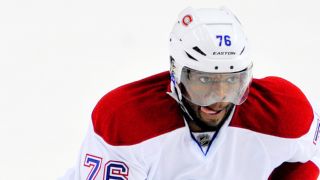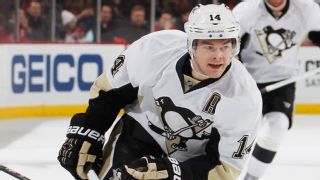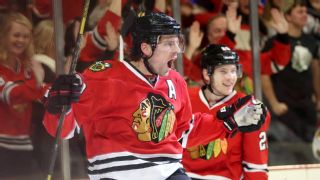|
In the end, it's only an embarrassment of riches if you get it right. So when the man tasked with announcing Canada's men's Olympic hockey team, Hall of Famer Steve Yzerman, sat down to make the final crucial decisions on the 25-man roster that will be announced Tuesday morning, we can only imagine that having so many gems with which to decorate his Olympic crown is its own double-edged sword. From the outside, when you consider whether you can take Rick Nash, Claude Giroux and Martin St. Louis on the right side, or which of Chris Kunitz, Jamie Benn and Matt Duchene fits on the left, you could hardly go wrong, right? Wrong.  The fact that Yzerman will leave off however many (eight? 10? 12?) world-class hockey players on Tuesday morning doesn't ensure anything other than the level of debate going up five or six notches once the squad is actually named. The fact that Yzerman will leave off however many (eight? 10? 12?) world-class hockey players on Tuesday morning doesn't ensure anything other than the level of debate going up five or six notches once the squad is actually named.
If anything, the naming of the squad only heightens the pressure on those who made the cut and focuses more attention on those who didn't leading into the tournament, which begins in a little more than a month. Take Montreal Canadiens defenseman P.K. Subban, who would appear to be in a battle for one of the final roster spots with Dan Boyle, Brent Seabrook and perhaps Mark Giordano. If Subban makes the team as the final right-handed defenseman, every shift in Sochi -- assuming he gets on the ice -- will be scrutinized, every mistake magnified, given the polarizing element he represents heading into the selection process. If he doesn't make the team and Canada struggles to generate offense from the back end or from the power play, there will be a chorus of "I told you so's" at the defending Norris trophy winner's exclusion. Subban illustrates the various elements Yzerman must consider in filling out this roster. Is a player defensively responsible? Is he a true 200-foot player, able to take care of his business the length of the ice? What is his experience historically in pressure situations and how does that juxtapose against his level of play during the first half of this current NHL season? It's believed the Canadian selection group would like an even split of right-handed and left-handed defensemen among their eight, which in some ways would simplify the process up front. It is also believed that the decision is down to 17 or so forwards who will be among the 14 named. Nash, for instance, has had an up-and-down first half but was terrific in Vancouver four years ago. Benn, Duchene and Giroux have no Olympic experience but have evolved into elite players who are, in many ways, deserving of one of the 25 roster spots. How much will Yzerman lean toward trying to include instant karma? Corey Perry and Ryan Getzlaf of Anaheim are locks. But what about Patrick Sharp?  Has there been a hotter player of late? Does it just seem as if Sharp records a hat trick every night? (Technically, he has two in his past six games.) He is second in the league with 25 goals and has recorded at least a point in 11 of his last 14 games. Has there been a hotter player of late? Does it just seem as if Sharp records a hat trick every night? (Technically, he has two in his past six games.) He is second in the league with 25 goals and has recorded at least a point in 11 of his last 14 games.
Does his torrid pace playing alongside captain Jonathan Toews, another lock for one of the top three center positions for Canada, open a door for Sharp perhaps on the less-crowded left side? What about Chris Kunitz, who is among the league leaders in goals, playing on the left side with Sidney Crosby? Although Sharp can play a variety of positions and do different things, Kunitz is a special case in that his maximum value would seem to be playing on a line with Crosby. Is that enough? If Kunitz is left off the roster and Crosby doesn't get going early in the tournament, there will be questions about that decision. On it will go. What about Joe Thornton, another veteran of that gold-medal-winning team from four years ago? He is tied for third in points in the NHL, but does the big ice blunt his effectiveness, or do his puckhandling skills lend themselves to the wider ice surface? An embarrassment of riches to be sure, but no easy decisions, not when the only answer is gold. Eight years ago, Canada was once again favored when the tournament began in Turin. Canada's roster looked formidable, as it always does for these best-on-best tournaments. Sure, there were a few curious choices: Kris Draper, Todd Bertuzzi, although he was still an elite power forward, and Bryan McCabe as an injury replacement on the blue line. But this team was loaded with top-level players in their prime: Brad Richards, St. Louis and Vincent Lecavalier, all fresh from their Cup win in '04 in Tampa, Dany Heatley in his 50-goal prime, Nash, Joe Sakic et al.  The team, however, was nicked up, and too many injured players made the flight to Italy; the team never took off, struggling to find an offensive rhythm on the big ice. In a flash, it was over. The team, however, was nicked up, and too many injured players made the flight to Italy; the team never took off, struggling to find an offensive rhythm on the big ice. In a flash, it was over.
Canada was shut out by Switzerland and Finland in the round robin and by Russia in the quarterfinals. The team scored 15 goals in total (12 of those against Germany and host Italy) and no one player had more than two. Ken Hitchcock, the Jack Adams Award winner as coach of the year for 2011-12, was an assistant on the past three Canadian Olympic teams, winning gold in 2002 and 2010, sandwiched around that disappointment in Italy. The injuries were a significant factor in 2006, but Hitchcock also noted that the team never really learned how to play on the big ice in spite of much discussion before the tournament about the need for adjustment. Foot speed is very important, "but the ability to transition the puck is equally important," Hitchcock told ESPN.com before Tuesday's announcement. Hitchcock will return for a fourth Olympic tournament in Sochi. He said Team Canada incorporated most of the changes it felt were needed after the '06 tournament, and the adjustments paid off in a gold medal in Vancouver. Still, he noted, the big ice surface is deceivingly demanding in terms of physicality. "It takes you longer to get to places," Hitchcock explained. As such, positional play is key. "The size of the ice impacts a lot of things," he added. Although all the teams play on the same ice, he said the two North American teams have the most to learn on the fly, given that the European players -- even those who have played long careers in the NHL -- are simply more familiar with the nuances of the bigger surface, having grown up playing on that ice. "We have to be ready for those adjustments," Hitchcock said. That tournament in Italy was a long time ago, of course, but it serves as a stark lesson that the difficult choices confronting Yzerman and his group in coming up with Tuesday's list do not guarantee anything other than the expectation of perfection. Nothing more, nothing less.
|

